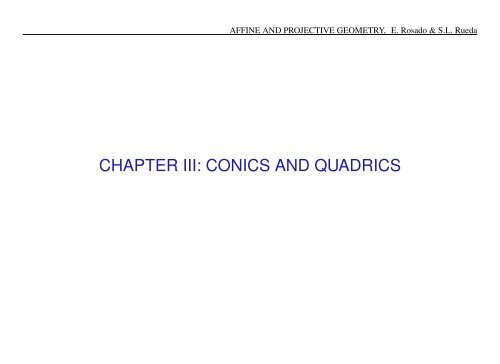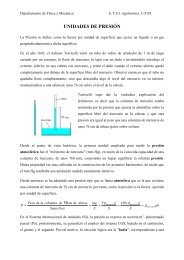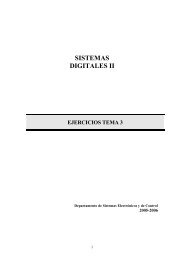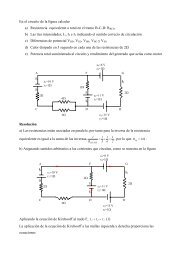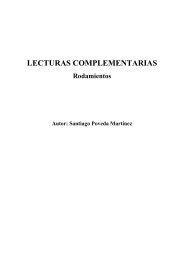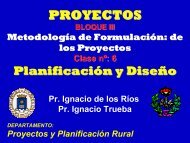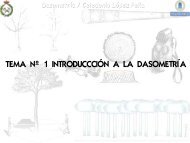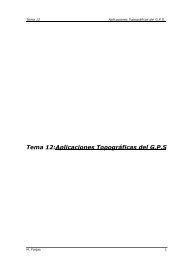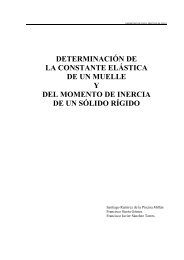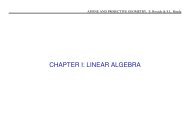CHAPTER III: CONICS AND QUADRICS - OCW UPM
CHAPTER III: CONICS AND QUADRICS - OCW UPM
CHAPTER III: CONICS AND QUADRICS - OCW UPM
You also want an ePaper? Increase the reach of your titles
YUMPU automatically turns print PDFs into web optimized ePapers that Google loves.
AFFINE <strong>AND</strong> PROJECTIVE GEOMETRY, E. Rosado & S.L. Rueda<br />
<strong>CHAPTER</strong> <strong>III</strong>: <strong>CONICS</strong> <strong>AND</strong> <strong>QUADRICS</strong>
AFFINE <strong>AND</strong> PROJECTIVE GEOMETRY, E. Rosado & S.L. Rueda<br />
4. <strong>QUADRICS</strong><br />
Let P 3 = P(R 4 ) be the real projective tridimensional space.<br />
Definition. A quadric Q in P 3 determined by a quadratic form ω : R 4 −→ R is<br />
the set of points of P 3 defined by:<br />
Q = {X ∈ P 3 | ω(X) = 0}<br />
Let R = {O, B} be a coordinate system in A 3 and let<br />
⎛<br />
⎞<br />
a 00 a 01 a 02 a 03<br />
a<br />
A = 01 a 11 a 12 a 13<br />
⎜<br />
⎟<br />
⎝ a 02 a 12 a 22 a 23 ⎠<br />
a 03 a 13 a 23 a 33<br />
be the matrix associated to the quadratic form ω then<br />
Q = {X ∈ P 3 | X t AX = 0}<br />
⎧<br />
⎨<br />
=<br />
⎩ [(x 0, x 1 , x 2 , x 3 )] ∈ P 3 |<br />
3∑<br />
i=0<br />
⎫<br />
3∑ ⎬<br />
a ij x i x j = 0<br />
⎭<br />
j=0
AFFINE <strong>AND</strong> PROJECTIVE GEOMETRY, E. Rosado & S.L. Rueda<br />
The affine quadric defined by the quadratic form ω is the subset Q of A 3<br />
defined by<br />
Q = {X ∈ A 3 | ω( ˜X) = 0},<br />
where ˜X = (1, x 1 , x 2 , x 3 ), with (x 1 , x 2 , x 3 ) ∈ A 3 . It is verified that Q ⊂ Q.
AFFINE <strong>AND</strong> PROJECTIVE GEOMETRY, E. Rosado & S.L. Rueda<br />
4.1 Singular points and projective classification<br />
Let Q be a projective quadric determined by a quadratic form ω : R 4 −→ R,<br />
with polar form f : R 4 × R 4 −→ R and associated matrix A with respect to<br />
certain coordinate system.<br />
Definitions.<br />
We say that two points A, B ∈ P 3 are conjugated with respect to Q if<br />
f(A, B) = 0.<br />
We say that a point P ∈ P 3 is an autoconjugated point with respect to<br />
Q if ω(P ) = f(P, P ) = 0.<br />
We say that a point P ∈ P 3 is a singular point of Q if it is conjugated<br />
with every point of P 3 ; this is, f(P, X) = 0 for every point X ∈ P 3 . This<br />
is, if<br />
f(P, X) = P T AX = 0, ∀X ∈ P 3 ,<br />
or equivalently,<br />
P T A = 0.
AFFINE <strong>AND</strong> PROJECTIVE GEOMETRY, E. Rosado & S.L. Rueda<br />
We say that a point P ∈ P 3 is a regular point of Q if it is not a singular<br />
point<br />
The quadric Q is non degenerate, regular or ordinary if it does not have<br />
singular points.<br />
The quadric Q is degenerate or singular if it has a singular point.
AFFINE <strong>AND</strong> PROJECTIVE GEOMETRY, E. Rosado & S.L. Rueda<br />
Observations: Let Q be a projective quadric generated by a quadratic form<br />
ω, with polar form f and associated matrix A.<br />
1. Let sign(Q) be the set of singular points of Q; this is,<br />
sign(Q) = {X ∈ P 3 | f(X, Y ) = 0, for every Y ∈ P 3 }<br />
= {X ∈ P 3 | AX = 0}.<br />
We have<br />
dim(sign(Q)) = 3 − rank(A).<br />
2. If X ∈ P 3 is a singular point, then X ∈ Q.<br />
Proof. We have to check that ω(X) = 0. We have ω(X) = f(X, X) = 0<br />
as X is conjugated with any point, in particular with itself.
AFFINE <strong>AND</strong> PROJECTIVE GEOMETRY, E. Rosado & S.L. Rueda<br />
3. The line determined by a singular point X and any other point of the<br />
quadric, Y ∈ Q, is contained on the quadric.<br />
Proof. As X is singular we know that ω(X) = 0 and f(X, Y ) = 0 and<br />
as Y belongs to the quadric ω(Y ) = 0. Any point of the line determined<br />
by X and Y has the form Z = λX + µY . We have to check whether<br />
ω(Z) = 0. We have:<br />
ω(Z) = ω(λX + µY ) = f(λX + µY, λX + µY )<br />
= f(λX, λX + µY ) + f(µY, λX + µY )<br />
= f(λX, λX) + f(λX, µY ) + f(µY, λX) + f(µY, µY )<br />
= λ 2 f(X, X) + 2λµf(X, Y ) + µ 2 f(Y, Y )<br />
= λ 2 ω(X)<br />
} {{ }<br />
0<br />
+ 2λµf(X, Y )<br />
} {{ }<br />
0<br />
+ µ 2 ω(Y )<br />
} {{ }<br />
0<br />
= 0.<br />
4. All the points that belong to the line determined by two singular points<br />
are singular.
AFFINE <strong>AND</strong> PROJECTIVE GEOMETRY, E. Rosado & S.L. Rueda<br />
Proof. Let Z = λX + µY be any point of the line formed by two singular<br />
points X and Y . We have to check that f(Z, T ) = 0, for every T ∈ P 3 .<br />
We have:<br />
f(Z, T ) = f(λX + µY, T )<br />
= f(λX, T ) + f(µY, T )<br />
= λf(X, T )<br />
} {{ }<br />
0<br />
+ µf(Y, T )<br />
} {{ } = 0.<br />
5. If the quadric Q contains a singular point, then Q is formed by lines that<br />
contain that point.<br />
0
4.1.1 Projective classification<br />
AFFINE <strong>AND</strong> PROJECTIVE GEOMETRY, E. Rosado & S.L. Rueda<br />
1. If det A ≠ 0, then the quadric Q is ordinary or not degenerate.<br />
2. If det A = 0, then the quadric Q is degenerate.<br />
a) If rank(A) = 3, then Q has an unique singular point P .<br />
If P is a proper point, then Q is a cone with vertex P .<br />
If P is an improper point, then Q is a cylinder.<br />
b) If rank(A) = 2, then Q has a line of singular points and Q is a pair of<br />
planes with intersection the line of singular points.<br />
c) If rank(A) = 1, then Q has a plane of singular points and Q is a<br />
double plane.
AFFINE <strong>AND</strong> PROJECTIVE GEOMETRY, E. Rosado & S.L. Rueda<br />
4.2 Polarity defined by a quadric<br />
Let Q be a quadric with polar form f and associated matrix A. Let us consider<br />
P ∈ P 3 , we call polar variety of P with respect to the quadric Q to the<br />
set of conjugated points of P ; this is,<br />
V P = {X ∈ P 3 | f(P, X) = 0}<br />
= {X ∈ P 3 | P t AX = 0}.<br />
If P ∈ P 3 is a singular points, then V P = P 3 .<br />
If P ∈ P 3 is not a singular point, then V P is a plane π P and we call it polar<br />
plane of P with respect to the quadric Q:<br />
π P = {X ∈ P 3 | P t AX = 0}.
AFFINE <strong>AND</strong> PROJECTIVE GEOMETRY, E. Rosado & S.L. Rueda<br />
Definition. Given a plane π of the space P 3 , we call pole of the plane π with<br />
respect to the quadric Q to the point whose polar plane is π; this is, π P = π.<br />
If the equation of the plane π is<br />
then π P = π if and only if<br />
π ≡ u 0 x 0 + u 1 x 1 + u 2 x 2 + u 3 x 3 = U T X = 0,<br />
with U = (u 0 , u 1 , u 2 , u 3 ) and X = (x 0 , x 1 , x 2 , x 3 ),<br />
P T AX = U T X, for every X ∈ P 3<br />
equivalently,<br />
P T A = U T ⇐⇒ AP = U.<br />
And if the quadric Q is not degenerate (therefore, det A ≠ 0), then P =<br />
A −1 U.
AFFINE <strong>AND</strong> PROJECTIVE GEOMETRY, E. Rosado & S.L. Rueda<br />
Theorem. If the point P belongs to the polar plane of a point R, then the<br />
point R is in the polar plane of P .<br />
This is due to the condition of conjugation f(P, R) = 0 ; it is symmetric in P<br />
and R.<br />
As we have seen, given a quadric Q, every non sigular point P is assigned<br />
a plane (its polar plane) and reciprocally, each plane π is assigned a point<br />
(its pole).<br />
Definition. We call polarity defined by a quadric Q to the transformation in<br />
which each non singular point of Q is assigned to its polar plane. This is,<br />
P 3 sign(Q) −→ Planes of P 3<br />
P ↦−→ π P
AFFINE <strong>AND</strong> PROJECTIVE GEOMETRY, E. Rosado & S.L. Rueda<br />
Fundamental theorem of polarity<br />
The polar planes of the points of a plane π of P 3 , with respect to a regular<br />
quadric Q, contain the same point which is precisely the pole of π.
AFFINE <strong>AND</strong> PROJECTIVE GEOMETRY, E. Rosado & S.L. Rueda<br />
4.3 Intersection between line and quadric<br />
Let Q be a projective quadric with polar form f and associated matrix A.<br />
Let r be the projective line which contains the independent points P =<br />
[(p 0 , p 1 , p 2 , p 3 )] and Q = [(q 0 , q 1 , q 2 , q 3 )].<br />
A point X ∈ P 3 is in the intersection between the conic and the line if and<br />
only if:<br />
{ X ∈ r<br />
X ∈ Q ⇐⇒ { X = λP + µQ<br />
ω(X) = 0<br />
The condition ω(λP + µQ) = 0 is written:<br />
⇐⇒<br />
{ X = λP + µQ<br />
ω(λP + µQ) = 0<br />
0 = λ 2 ω(P ) + 2λµf(P, Q) + µ 2 ω(Q).<br />
Dividing the former equation by µ 2 and writing t = λ/µ we obtain the following<br />
second degree equation:<br />
0 = ω(P )t 2 + 2f(P, Q)t + ω(Q)
with discriminant<br />
AFFINE <strong>AND</strong> PROJECTIVE GEOMETRY, E. Rosado & S.L. Rueda<br />
∆ = f(P, Q) 2 − ω(P )ω(Q).<br />
If f(P, Q) = 0, ω(P ) = 0 and ω(Q) = 0, then P, Q ∈ Q and, therefore,<br />
r ⊂ Q.<br />
If not all the coefficients of the second degree equation 0 = ω(P )t 2 +<br />
2f(P, Q)t + ω(Q) are zero, then there are two intersection points (the<br />
two solutions of the equation).<br />
1. If ∆ = f(P, Q) 2 − ω(P )ω(Q) > 0, the line, and the quadric intersect in<br />
two different real points. The line is called secant line to the quadric.<br />
2. If ∆ = f(P, Q) 2 − ω(P )ω(Q) = 0, the line and the quadric intersect in<br />
a double point. The line is called tangent line to the quadric.<br />
3. If ∆ = f(P, Q) 2 − ω(P )ω(Q) < 0, the line and the conic intersect in<br />
two different improper points. The line is called exterior line to the<br />
quadric.
AFFINE <strong>AND</strong> PROJECTIVE GEOMETRY, E. Rosado & S.L. Rueda<br />
4.3.1 Tangent variety to a quadric<br />
Definition. The tangent variety to a quadric Q in a point P ∈ P 3 , is the set of<br />
points X ∈ P 3 such that the line that joins P and X is tangent to the quadric<br />
Q; this is,<br />
Observations.<br />
T P Q = {X ∈ P 3 | line XP is tangent to Q}<br />
= {X ∈ P 3 | ∆ = f(P, X) 2 − ω(P )ω(X) = 0}<br />
= {X ∈ P 3 | f(P, X) 2 = ω(P )ω(X)}.<br />
1. T P Q is a degenerate quadric which has P as singular point.<br />
2. If P ∈ Q is a regular point, then<br />
T P Q = {X ∈ P 3 | f(P, X) 2 = 0}<br />
= {X ∈ P 3 | P t AX = 0}<br />
is a plane, called the tangent plane to Q in P . In fact, it is the polar plane<br />
of the point P ; this is, T P Q = π p .
3. If P ∈ Q is a singular point, then T P Q = P 3 .<br />
AFFINE <strong>AND</strong> PROJECTIVE GEOMETRY, E. Rosado & S.L. Rueda<br />
4.4 Affine classification and notable elements of quadrics<br />
Let A 3 = P(R 4 ) be the projectivized affine space, with coordinate system<br />
R = {O, B}. And let ω be a quadratic form with associated matrix A. Let<br />
Q = {X ∈ P 3 (R 4 ) | ω(X) = 0<br />
be a projective quadric with affine quadric<br />
Q = Q ∩ A 3 = {X ∈ A 3 | ω( ˜X) = 0}, where ˜X = (1, x 1 , x 2 , x 3 ).
AFFINE <strong>AND</strong> PROJECTIVE GEOMETRY, E. Rosado & S.L. Rueda<br />
4.4.1 Center of an affine quadric<br />
Definition. We call center of an affine quadric Q to the pole of the plane at<br />
infinity, if it exists. If that point is contained in the plane at infinity then the<br />
quadric has an improper center, otherwise a proper center.<br />
The equation of the plane at infinity is x 0 = 0 and the equation of the quadric<br />
is X t AX = 0. Therefore, the pole of the plane at infinity is the point P such<br />
that P t A = (1, 0, 0, 0).<br />
Proposition. The proper center of an affine quadric is the center of symmetry.<br />
Any line that contains the center of a quadric intersects the quadric in<br />
two symmetric points with respect to the center.
AFFINE <strong>AND</strong> PROJECTIVE GEOMETRY, E. Rosado & S.L. Rueda<br />
4.4.2 Relative position of the quadric and the plane at infinity<br />
Let π ∞ ≡ x 0 = 0 be the equation of the plane at infinity and let us consider<br />
the projective quadric Q determined by a quadratic form ω and with<br />
associated matrix ⎛<br />
⎞<br />
a 00 a 01 a 02 a 03<br />
a<br />
A = 01 a 11 a 12 a 13<br />
⎜<br />
⎟<br />
⎝ a 02 a 12 a 22 a 23 ⎠ .<br />
a 03 a 13 a 23 a 33<br />
We have:<br />
this is,<br />
Q ∩ π ∞ = {X ∈ π ∞ | ω(X) = 0} = { (0, x 1 , x 2 , x 3 ) | X t AX = 0 }<br />
Q ∩ π ∞ ≡ a 11 x 2 1 + a 22 x 2 2 + a 33 x 2 3 + 2a 12 x 1 x 2 + 2a 13 x 1 x 3 + 2a 23 x 2 x 3 = 0,
AFFINE <strong>AND</strong> PROJECTIVE GEOMETRY, E. Rosado & S.L. Rueda<br />
then Q ∩ π ∞ is a conic of the plane at infinity π ∞ with matrix<br />
⎛<br />
⎞<br />
a 11 a 12 a 13<br />
A 00 = ⎝ a 12 a 22 a 23<br />
⎠ .<br />
a 13 a 23 a 33<br />
Proposition. The quadric Q has a center if and only if det A 00 ≠ 0. Besides,<br />
If det A 00 ≠ 0, then the conic Q ∩ π ∞ is regular and Q has a center.<br />
If det A 00 = 0, then the conic Q ∩ π ∞ is degenerate and Q has no center.
4.4.3 Diameters of a quadric<br />
AFFINE <strong>AND</strong> PROJECTIVE GEOMETRY, E. Rosado & S.L. Rueda<br />
Definition. We call diameter of a quadric Q to every line that contains the<br />
center of Q.<br />
Definition. We call diametral plane of a quadric Q to the planes that contain<br />
the center of Q.<br />
Definition. Two diameters D and D ′ are said conjugated if their improper<br />
points are conjugated.<br />
Definition. We call diametral polar plane of a diameter D to the polar plane<br />
of the improper point of D.
AFFINE <strong>AND</strong> PROJECTIVE GEOMETRY, E. Rosado & S.L. Rueda<br />
4.4.4 Axes of a quadric with proper center<br />
Definition. We call axis of a quadric Q to the diameter which is perpendicular<br />
to its diametral polar plane.<br />
Let Q be a projective quadric with associated matrix A. And let A 00 be the<br />
matrix of the conic Q ∩ π ∞ .<br />
As Q has a proper center Z, the matrix A 00 is not singular, so its three<br />
eigenvalues are not zero λ 1 , λ 2 and λ 3 .<br />
Let v 1 , v 2 and v 3 be the eigenvectors associated to λ 1 , λ 2 and λ 3 respectively<br />
(we choose the eigenvectors which are orthogonal two by two).<br />
The axes of Q are the lines that contain the center, Z, and have as directions<br />
the vectors v 1 , v 2 and v 3 , respectively.
AFFINE <strong>AND</strong> PROJECTIVE GEOMETRY, E. Rosado & S.L. Rueda<br />
The coordinate system R = {Z, {v 1 , v 2 , v 3 }} gives us a cartesian autoconjugated<br />
coordinate system.<br />
We can find three situations:<br />
1. The three eigenvalues are different. Then Q has three axes which are<br />
orthogonal two by two.<br />
2. An eigenvalue is double, λ 1 = λ 2 , and the other, λ 3 , is simple. Then the<br />
dimension of the subspace of eigenvectors associated to the double<br />
eigenvalue is dim V 1 = 2 and dim V 3 = 1. Then V 1 is a plane of axes<br />
perpendicular to the axis V 3 . In this case the quadric Q is a revolution<br />
quadric, whose axis is the one that corresponds to the eigenvalue λ 3 .<br />
3. The three eigenvalues are the same, λ 1 = λ 2 = λ 3 . Then any diameter<br />
is the axis and the quadric is a sphere.<br />
Definition. We call main planes of a quadric Q to the diametral polar planes<br />
of the axes.
4.4.5 Asymptotic cones<br />
AFFINE <strong>AND</strong> PROJECTIVE GEOMETRY, E. Rosado & S.L. Rueda<br />
Definition. We call asymptotes of a quadric Q to the tangents of a conic in<br />
its improper points.<br />
Let Q be a projective quadric with proper center Z.<br />
Definition. The tangent variety to the quadric Q from the center Z [(z 0 , z 1 , z 2 , z 3 )]<br />
is a cone that is called asymptotic cone. The equation of the asymptotic<br />
cone is the following one:<br />
f(Z, X) 2 − ω(Z)ω(X) = 0 ⇐⇒ (Z t AX)(Z t AX) − (Z t AZ)(X t AX) = 0<br />
equivalently<br />
⇐⇒ x 2 0 − z 0 (X t AX) = 0<br />
⇐⇒ x 2 0 − det A 00<br />
det A (Xt AX) = 0<br />
det A<br />
det A 00<br />
x 2 0 − Q = 0.<br />
The quadrics of ellyptic type have an imaginary asymptotic cone and the<br />
quadrics of hyperbolic type have a real asymptotic cone.
AFFINE <strong>AND</strong> PROJECTIVE GEOMETRY, E. Rosado & S.L. Rueda<br />
The generatrixs of the cone (lines of the cone) are the diameters tangent to<br />
the quadric.<br />
We call asymptotic plane to the polar planes of the points of the improper<br />
conic of Q (Q ∩ π ∞ = C) (if there exists any).<br />
Example 1. Let us consider the quadric Q ≡ x 2 1 + 3x 2 3 + 4x 1 x 2 + 2x 3 + 2 = 0.<br />
The matrix of Q is:<br />
⎛ ⎞<br />
2 0 0 1<br />
0 1 2 0<br />
A = ⎜ ⎟<br />
⎝ 0 2 0 0 ⎠<br />
1 0 0 3<br />
The determinant of A is det A = −20, quadric with proper center:<br />
⎛ ⎞<br />
2 0 0 1<br />
( )<br />
0 1 2 0<br />
z0 z 1 z 2 z 3 ⎜ ⎟<br />
⎝ 0 2 0 0 ⎠ = ρ ( 1 0 0 0 ) ,<br />
1 0 0 3
this is<br />
AFFINE <strong>AND</strong> PROJECTIVE GEOMETRY, E. Rosado & S.L. Rueda<br />
⎧⎪ ⎨<br />
⎪ ⎩<br />
2z 0 + z 3 = ρ<br />
z 1 + 2z 2 = 0<br />
2z 1 = 0<br />
z 0 + 3z 3 = 0<br />
The center is: Z [(1, 0, 0, −1/3)].<br />
Equation of the asymptotic cone:<br />
det A<br />
det A 00<br />
x 2 0 − Q = 0 ⇐⇒ 20<br />
12 x2 0 − (x 2 1 + 3x 2 3 + 4x 1 x 2 + 2x 3 x 0 + 2x 2 0) = 0<br />
⇐⇒ 2x 0 x 3 + 4x 1 x 2 + 1 3 x2 0 + x 2 1 + 3x 2 3 = 0
4.5 Metric invariants of a quadric Q<br />
AFFINE <strong>AND</strong> PROJECTIVE GEOMETRY, E. Rosado & S.L. Rueda<br />
Let us consider the quadric Q with associated matrix A; this is, Q ≡ X T AX =<br />
0. The following values are euclidean invariants of the quadric:<br />
det A<br />
Eigenvalues of A 00 : λ 1 , λ 2 , λ 3 or equivalently:<br />
det A 00 , tr A 00 = a 11 + a 22 + a 33 , J =<br />
∣ a ∣ 11 a 12 ∣∣∣ +<br />
a 12 a 22<br />
∣ a ∣ 11 a 13 ∣∣∣ +<br />
a 13 a 33<br />
∣ a ∣<br />
22 a 23 ∣∣∣<br />
a 33<br />
a 23<br />
where<br />
A =<br />
⎛<br />
⎜<br />
⎝<br />
⎞<br />
a 00 a 01 a 02 a 03<br />
a 01 a 11 a 12 a 13<br />
⎟<br />
a 02 a 12 a 22 a 23<br />
a 03 a 13 a 23 a 33<br />
⎠ and A 00 =<br />
⎛<br />
⎝<br />
⎞<br />
a 11 a 12 a 13<br />
a 12 a 22 a 23<br />
⎠ .<br />
a 13 a 23 a 33
AFFINE <strong>AND</strong> PROJECTIVE GEOMETRY, E. Rosado & S.L. Rueda<br />
The following identities are satisfied:<br />
det A 00 = λ 1 λ 2 λ 3<br />
J = λ 1 λ 2 + λ 1 λ 3 + λ 2 λ 3<br />
tr A 00 = λ 1 + λ 2 + λ 3<br />
The charasteristic equation of A 00 is:<br />
|A 00 − λI 3 | = −λ 3 + tr A 00 λ 2 − Jλ + det A 00 = 0.<br />
Therefore, λ 1 , λ 2 and λ 3 are the roots of the equation |A 00 − λI 3 | = 0.<br />
If det A 00 ≠ 0, then the conic Q ∩ π ∞ is regular and Q has a center.<br />
If det A 00 = 0, then the conic Q ∩ π ∞ is not regular. It is a quadric of parabolloid<br />
type, it may not have a center, have a line of centers or even have a<br />
plane of centers.
4.5.1 Classification of quadrics with det A 00 ≠ 0.<br />
AFFINE <strong>AND</strong> PROJECTIVE GEOMETRY, E. Rosado & S.L. Rueda<br />
Because of det A 00 = λ 1 λ 2 λ 3 ≠ 0, in certain coordinate system, the matrix of<br />
the quadric is<br />
⎛<br />
⎞<br />
d 0 0 0 0<br />
0 λ 1 0 0<br />
⎜<br />
⎟<br />
⎝ 0 0 λ 2 0 ⎠<br />
0 0 0 λ 3<br />
and, therefore, the reduced equation of the affine quadric (x 0 = 0) is<br />
d 0 + λ 1 x 2 1 + λ 2 x 2 2 + λ 3 x 2 3 = 0<br />
with d 0 = det A<br />
det A 00<br />
and they are quadrics with center.<br />
If det A = d 0 λ 1 λ 2 λ 3 ≠ 0 (this is, rank(A) = 4) then they are ordinary quadrics.
We can distinguish two cases:<br />
AFFINE <strong>AND</strong> PROJECTIVE GEOMETRY, E. Rosado & S.L. Rueda<br />
1. the eigenvalues of A 00 have the same sign<br />
2. two of the eigenvalues of A 00 have the same sign and the other the<br />
opposite sign.
AFFINE <strong>AND</strong> PROJECTIVE GEOMETRY, E. Rosado & S.L. Rueda<br />
1. If sign(λ 1 ) = sign(λ 2 ) = sign(λ 3 ) (+ + + o − − −), we say that A 00 has<br />
signature 3, sig A 00 = 3, and we can encounter the following cases:<br />
a) If sign(d 0 ) = sign(λ 1 ) = sign(λ 2 ) = sign(λ 3 ), then det A > 0 and the<br />
reduced equation of the affine quadric is<br />
1 = − x2 1<br />
a − x2 2<br />
2 b − x2 3<br />
2 c 2<br />
where a 2 = d 0 /λ 1 , b 2 = d 0 /λ 2 and c 2 = d 0 /λ 3 (as the three of them<br />
are positive) which is the equation of an imaginary ellipsoid.<br />
b) If sign(d 0 ) ≠ sign(λ 1 ) = sign(λ 2 ) = sign(λ 3 ), then det A < 0 and the<br />
reduced equation of the affine quadric is<br />
1 = x2 1<br />
a + x2 2<br />
2 b + x2 3<br />
2 c 2<br />
where a 2 = −d 0 /λ 1 , b 2 = −d 0 /λ 2 and c 2 = −d 0 /λ 3 (as the three<br />
of them are positive) which is the equation of an ellipsoid, and if<br />
besides a 2 = b 2 = c 2 we obtain a sphere.
AFFINE <strong>AND</strong> PROJECTIVE GEOMETRY, E. Rosado & S.L. Rueda<br />
2. If sign(λ 1 ) = sign(λ 2 ) ≠ sign(λ 3 ) (+ + − o − − +) we say that A 00 has<br />
signature 1, sig A 00 = 1, and we can encounter the following cases:<br />
a) If sign(d 0 ) ≠ sign(λ 1 ) = sign(λ 2 ) ≠ sign(λ 3 ), then det A > 0 and the<br />
reduced equation of the affine quadric is<br />
1 = x2 1<br />
a + x2 2<br />
2 b − x2 3<br />
2 c 2<br />
where a 2 = −d 0 /λ 1 , b 2 = −d 0 /λ 2 and c 2 = d 0 /λ 3 (as the three of them<br />
are positive) which is the equation of an hyperbolic hyperboloid.<br />
b) If sign(d 0 ) = sign(λ 1 ) = sign(λ 2 ) ≠ sign(λ 3 ), then det A < 0 and the<br />
reduced equation of the quadric is<br />
1 = − x2 1<br />
a − x2 2<br />
2 b + x2 3<br />
2 c 2<br />
where a 2 = d 0 /λ 1 , b 2 = d 0 /λ 2 and c 2 = −d 0 /λ 3 (as the three of them<br />
are positive) which is the equation of an elliptic hyperboloid.
AFFINE <strong>AND</strong> PROJECTIVE GEOMETRY, E. Rosado & S.L. Rueda<br />
If det A = d 0 λ 1 λ 2 λ 3 = 0 (this is, d 0 = 0 and rank(A) = 3) then they are<br />
degenerate quadrics with reduced equation:<br />
We can distinguish two cases:<br />
λ 1 x 2 1 + λ 2 x 2 2 + λ 3 x 2 3 = 0<br />
1. If sign(λ 1 ) = sign(λ 2 ) = sign(λ 3 ), the reduced equation of the affine<br />
quadric is<br />
0 = λ 1 x 2 1 + λ 2 x 2 2 + λ 3 x 2 3<br />
which is the equation of an imaginary cone.<br />
2. If sign(λ 1 ) = sign(λ 2 ) ≠ sign(λ 3 ), the reduced equation of the affine<br />
quadric is of the form<br />
which is the equation of an cone.<br />
0 = a 2 x 2 1 + b 2 x 2 2 − c 2 x 2 3
AFFINE <strong>AND</strong> PROJECTIVE GEOMETRY, E. Rosado & S.L. Rueda<br />
Table of classification of quadrics with center<br />
⎧<br />
⎧<br />
{<br />
det A > 0 imaginary<br />
det A 00 ≠ 0<br />
⎪⎨<br />
rank(A) = 4<br />
Regular<br />
⎪⎨<br />
⎪⎩<br />
sig A 00 = 3<br />
Ellipsoids<br />
sig A 00 = 1<br />
Hyperboloids<br />
det A < 0 real<br />
{<br />
det A > 0 hyperbolic<br />
det A < 0<br />
elliptic<br />
⎪⎩<br />
rank(A) = 3<br />
Cones<br />
{<br />
sig A00 = 3 Imaginary cone with a real point<br />
sig A 00 = 1<br />
Real cone
AFFINE <strong>AND</strong> PROJECTIVE GEOMETRY, E. Rosado & S.L. Rueda<br />
4.5.2 Classification of the quadrics with det A 00 = 0.<br />
Because of det A 00 = λ 1 λ 2 λ 3 = 0, we can suppose λ 3 = 0.<br />
Hence J = λ 1 λ 2 .<br />
In certain coordinate system the matrix of the quadric is<br />
⎛<br />
⎜<br />
⎝<br />
b 00 0 0 b 03<br />
0 λ 1 0 0<br />
0 0 λ 2 0<br />
b 03 0 0 0<br />
with det A = −b 2 03λ 1 λ 2 .<br />
The reduced equation of the affine quadric is<br />
⎞<br />
⎟<br />
⎠<br />
0 = b 00 + λ 1 x 2 1 + λ 2 x 2 2.
AFFINE <strong>AND</strong> PROJECTIVE GEOMETRY, E. Rosado & S.L. Rueda<br />
If J = λ 1 λ 2 ≠ 0 we can distinguish various cases:<br />
1. If det A ≠ 0 (this is, b 03 ≠ 0) The reduced equation of the affine quadric<br />
is<br />
0 = 2b 03 x 3 + λ 1 x 2 1 + λ 2 x 2 2<br />
and we have:<br />
a) If sign(λ 1 ) = sign(λ 2 ), this is J > 0, the reduced equation of the affine<br />
quadric is of the form<br />
0 = dx 3 + a 2 x 2 1 + b 2 x 2 2<br />
which is the equation of an elliptic paraboloid.<br />
b) If sign(λ 1 ) ≠ sign(λ 2 ), this is J < 0, the reduced equation of the affine<br />
quadric is of the form<br />
0 = dx 3 + a 2 x 2 1 − b 2 x 2 2<br />
which is the equation of an hyperbolic paraboloid.
AFFINE <strong>AND</strong> PROJECTIVE GEOMETRY, E. Rosado & S.L. Rueda<br />
2. If det A = 0 (this is, b 03 = 0) the reduced equation of the affine quadric is<br />
and we distinguish various cases:<br />
a) If b 00 ≠ 0 we have<br />
0 = b 00 + λ 1 x 2 1 + λ 2 x 2 2<br />
1) If sign(λ 1 ) = sign(λ 2 ), this is J > 0, the reduced equation of the<br />
affine quadric is of the form<br />
0 = c + a 2 x 2 1 + b 2 x 2 2<br />
which is the equation of an elliptic imaginary cylinder if c > 0 or<br />
elliptic cylinder if c < 0.<br />
2) If sign(λ 1 ) ≠ sign(λ 2 ), this is J < 0, the reduced equation of the<br />
affine quadric is of the form<br />
0 = c + a 2 x 2 1 − b 2 x 2 2<br />
which is the equation of a hyperbolic cylinder.
AFFINE <strong>AND</strong> PROJECTIVE GEOMETRY, E. Rosado & S.L. Rueda<br />
b) If b 00 = 0 the reduced equation of the quadric is<br />
0 = λ 1 x 2 1 + λ 2 x 2 2.<br />
1) If sign(λ 1 ) = sign(λ 2 ), this is J > 0, the affine quadric is a pair of<br />
imaginary planes which intersect in a line.<br />
2) If sign(λ 1 ) ≠ sign(λ 2 ), this is J < 0, the affine quadric is a pair of<br />
planes which intersect in a line.
AFFINE <strong>AND</strong> PROJECTIVE GEOMETRY, E. Rosado & S.L. Rueda<br />
If two of the eigenvalues of A 00 vanish (suppose λ 2 = λ 3 = 0), hence:<br />
det A = 0, det A 00 = 0, J = 0 and tr A 00 = λ 1 .<br />
In certain coordinate system the matrix of the quadric is<br />
⎛<br />
⎞<br />
b 00 0 0 0<br />
0 λ 1 0 0<br />
⎜<br />
⎟<br />
⎝ 0 0 0 0 ⎠<br />
0 0 0 0<br />
and the reduced equation of the quadric is<br />
1. If b 00 ≠ 0 we have<br />
0 = b 00 + λ 1 x 2 1.<br />
a) If sign(b 00 ) = sign(λ 1 ), the reduced equation of the affine quadric is of<br />
the form<br />
0 = p 2 + a 2 x 2 1<br />
and the affine quadric is a pair of imaginary parallel planes .
AFFINE <strong>AND</strong> PROJECTIVE GEOMETRY, E. Rosado & S.L. Rueda<br />
b) If sign(b 00 ) ≠ sign(λ 1 ), the reduced equation is of the form<br />
0 = p 2 − a 2 x 2 1 = (p + ax 1 )(p − ax 1 )<br />
and the affine quadric is a pair of parallel planes.
AFFINE <strong>AND</strong> PROJECTIVE GEOMETRY, E. Rosado & S.L. Rueda<br />
Table of classification of quadrics with det A 00 = 0<br />
det A 00 = 0<br />
⎧<br />
⎪⎨<br />
⎪⎩<br />
rank(A) = 4<br />
Regular<br />
rank(A) = 3<br />
Cylinders<br />
rank(A) = 2<br />
Pair of planes<br />
rank(A) = 1<br />
{<br />
J > 0 Elliptic paraboloid<br />
⎧<br />
⎪⎨<br />
J < 0<br />
J > 0<br />
J < 0<br />
⎪⎩<br />
J = 0<br />
⎧<br />
J > 0<br />
⎪⎨ J < 0<br />
⎪⎩<br />
J = 0<br />
double plane<br />
Hyperbolic paraboloid<br />
Real elliptic cylinder<br />
Hyperbolic cylinder<br />
Parabolic cylinder<br />
Pair of imaginary planes (line)<br />
Pair of secant planes<br />
Pair of parallel planes<br />
{<br />
imaginary<br />
real


